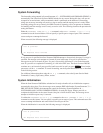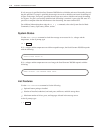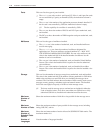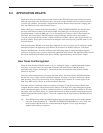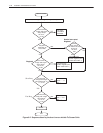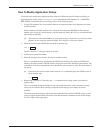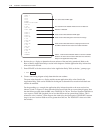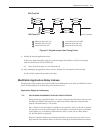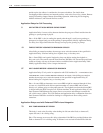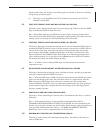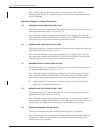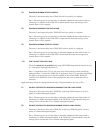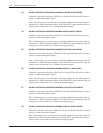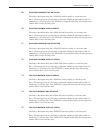
Maintenance
Commands 6-47
Octel Overture 200/300 Serenade 3.0
PB60014–01
Figure 6-3
Ring/No Answer T
one-T
iming Failure
PBX T
one ON
PBX Tone OFF
1000 ms
2880 ms
Answer Condition
800 ms
1200 ms
980 ms
800 ms
1200 ms
790 ms
1200 ms
2800 ms
3400 ms
2920 ms
2800 ms
3400 ms
Maximum Tone ON (53)
1
2
3
4
5
6
1
2
Minimum Tone ON (54)
3
4
5
6
Minimum Tone OFF (56)
Maximum Tone OFF (55)Actual Time Tone ON
Actual Time Tone was OFF
800 ms
9. Modify
the required application delays.
In this case, Application Delay index 54 would be changed from 800 ms to 760 ms. Decreasing
Index 54 allows for the 790 ms TONE ON.
.
Index 50 must be equal to or less than Index 54.
10.
After modifying the appropriate delays, remove Attribute 70, and retest the calls that failed.
If calls still fail, repeat this procedure from step 1.
Modifiable
Application-Delay Indexes
The
application-delay indexes that can be modified at the Maintenance level while in UPDA
TE are listed
below
, with descriptions of what the delay does and how to use it.
Application
Delays for Addressing
WAIT DURING ADDRESSING TO RESOLVE DIGIT ENTERED
During addressing, Application Delay 131 causes a delay between digit entries when 0 is the
first digit of mailboxes and extensions or when local mailbox addresses overlap network
prefixes. The default delay is 2.0 seconds.
Use —
When 0 is the initial digit for mailboxes and extensions, after 0, or 00–09 are entered,
the message server waits for more digits. If no more digits are entered, the call is transferred
to the operator (0), to the Dial-by-Name directory (00), or
, in the case of a PDL address
(01–09), the address is registered.
When local mailbox addresses overlap network prefixes, the message server waits for more
digits after the local mailbox address is entered. If more digits are entered before the timeout
131



